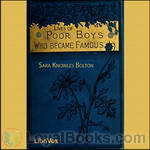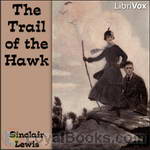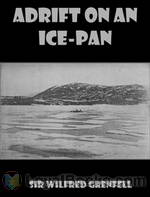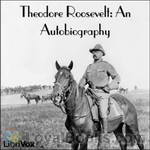|
Books Should Be Free Loyal Books Free Public Domain Audiobooks & eBook Downloads |
|
|
Books Should Be Free Loyal Books Free Public Domain Audiobooks & eBook Downloads |
|
Biographies |
|---|
|
Book type:
Sort by:
View by:
|
By: Samuel G Goodrich (1793-1860) | |
|---|---|
 Life of Benjamin Franklin
Life of Benjamin Franklin
This little book was intended for the education of school children and includes tales, sketches and anecdotes of his life written for the children of the mid 1800's and written in the English languge of that period. Each chapter has numerous questions intended for the the reader or the teacher to quiz themselves to see if they gathered the pertinent information. The quiz questions will not be recorded. Also part of this book are numerous short essays written by Franklin on various topics. These entertaining and insightful samples occupy sections 17 through 27. | |
By: Samuel Hopkins Hadley (1842-1906) | |
|---|---|
 Down In Water Street
Down In Water Street
Written by the Superintendent of the Jerry McAuley Water Street Mission, "Down in Water Street" is intended to share some of the experiences the writer had during his sixteen years of service to the Mission. Hadley's intent was to show "how some success has been achieved, and also mention some of our defeats; for we found long years ago that we often learn more in defeat than in victory." - Summary by Kristin Hand with a quote from the Preface | |
By: Samuel Smiles (1812-1904) | |
|---|---|
 Lives of the Engineers (George and Robert Stephenson)
Lives of the Engineers (George and Robert Stephenson)
George Stephenson did not invent the steam engine, that was due to Newcomen and later to James Watt. He did not invent the steam locomotive, that was due to a number of people including Cugnot, Trevithick and others. He did not invent the Railway. Railways or tramways had been in use for two hundred years before Stephenson.The reason why Stephenson was known as ‘The father of the steam locomotive’ was that he took a primitive, unreliable and wholly uneconomic device and turning it into an efficient... | |
By: Santa Teresa de Jesus (1515-1582) | |
|---|---|
 The Life of St. Teresa
The Life of St. Teresa
Saint Teresa of Ávila, also called Saint Teresa of Jesus, baptized as Teresa Sánchez de Cepeda y Ahumada, (March 28, 1515, at Gotarrendura (Ávila), Old Castile, Spain – October 4, 1582, at Alba de Tormes, Salamanca, Spain) was a prominent Spanish mystic, Carmelite nun, and writer of the Counter Reformation. She was a reformer of the Carmelite Order and is considered to be, along with John of the Cross, a founder of the Discalced Carmelites. In 1970 she was named a Doctor of the Church by Pope Paul VI. | |
By: Sarah Hopkins Bradford (1818-1912) | |
|---|---|
 Scenes in the Life of Harriet Tubman
Scenes in the Life of Harriet Tubman
A portrait of Harriet Tubman is scheduled to replace that of Andrew Jackson on the front of the U.S. $20 bill in 2020. Sarah H. Bradford, who knew Tubman personally, wrote these scenes from Tubman's extraordinary life in 1869. - Summary by Sue Anderson | |
By: Sarah Knowles Bolton | |
|---|---|
 Lives of Girls Who Became Famous
Lives of Girls Who Became Famous
This book is a collection of short biographies of notable women, including Harriet Beecher Stowe, Louisa May Alcott, Florence Nightingale, and many others. | |
 Lives of Poor Boys Who Became Famous
Lives of Poor Boys Who Became Famous
These characters have been chosen from various countries and from varied professions, that the youth who read this book may see that poverty is no barrier to success. It usually develops ambition, and nerves people to action. Life at best has much of struggle, and we need to be cheered and stimulated by the careers of those who have overcome obstacles.If Lincoln and Garfield, both farmer-boys, could come to the Presidency, then there is a chance for other farmer-boys. If Ezra Cornell, a mechanic, could become the president of great telegraph companies, and leave millions to a university, then other mechanics can come to fame... | |
 Famous American Statesmen
Famous American Statesmen
A sketch of the lives of some of America's early Statesmen: George Washington, Benjamin Franklin, Thomas Jefferson, Alexander Hamilton, Andrew Jackson, Daniel Webster, Henry Clay, Charles Sumner, Ulysses S. Grant, and James A. Garfield. | |
 Some Articles About Mark Twain
Some Articles About Mark Twain
"Samuel Langhorne Clemens", "Mark Twain At Home", "Youth of Mark Twain" & "Mark Twain Gossip" Published in the June 16, 1888 edition of "Literature - An Illustrated Weekly Magazine" these four, early magazine articles about Mark Twain fill in and analyze areas of Twain's persona for the first time. "Mark Twain At Home" was originally published in the London, England "World". | |
By: Sarah Raymond Herndon (1840-1914) | |
|---|---|
 Days on the Road: Crossing the Plains in 1865
Days on the Road: Crossing the Plains in 1865
“We had spent almost all our money for toll, ferrying and other expenses on the road. It might be a serious matter to be in a strange place without money . . . There is nothing we can spare so well as Dick. . . . It would not do to be sentimental under existing circumstances.” This is the practical pioneer woman Sarah Raymond Herndon writing in her journal about selling her horse to finance the final days of her family’s trek across the plains to Montana. However, when her brother, Hillhouse, actually sells her beloved pony, Sarah is distraught... | |
By: Silas Weir Mitchell (1829-1914) | |
|---|---|
 Youth of Washington: Told in the Form of an Autobiography
Youth of Washington: Told in the Form of an Autobiography
Departing from the usual third person narratives of biographies, this account is told in the first person as the reminiscences of a now retired George Washington. Reflecting on his days as a youth, he relates his family history, education, and military life up to the age of about 26 when he was a colonel. Naturally the author takes much liberty in filling in the details of Washington’s life, but largely remains true to history and the spirit of the man. The result is an engaging story that flows naturally, entertaining as it informs. - Summary by Larry Wilson | |
By: Sinclair Lewis | |
|---|---|
 The Trail of the Hawk
The Trail of the Hawk
| |
By: Sir Francis Galton (1822-1911) | |
|---|---|
 English Men of Science: Their Nature and Nurture
English Men of Science: Their Nature and Nurture
The results of a survey undertaken by Galton to learn more about individual differences and similarities between the "pre-eminent" men of his time. Brief biographical information, biometric data and extensive quotations have been compiled and presented. Summary by niobium. | |
 Hereditary Genius
Hereditary Genius
A biographical summary of the pre-eminent men of Britain grouped by profession. The extensive survey draws from information including college graduation, reputation during career, fellowships, and even known relatives. Includes discussions on findings and observations as well as referenced appendices. - Summary by Leon Harvey | |
By: Sir Frederick Maurice Powicke (1879-1963) | |
|---|---|
 Bismarck and the Origin of the German Empire
Bismarck and the Origin of the German Empire
Despite its brevity, this Little Blue Book #142 by the Oxford historian, Sir F.M. Powicke, provides a valuable overview of the political history of Germany from medieval to modern times, culminating in the career of Otto von Bismarck , the Prussian Junker who masterminded the unification of Germany and served as its first Chancellor. - Summary by Pamela Nagami, M.D. | |
By: Sir Henry Morton Stanley (1841-1904) | |
|---|---|
 How I Found Livingstone
How I Found Livingstone
Sir Henry Morton Stanley is famously quoted for saying “Dr Livingstone, i Presume?”. Born in Wales, he migrated over to the United States at the age of 18, and eventually became an overseas correspondent for the New York Herald. In 1869 Stanley was told by James Gordon Bennett Jr to find Livingstone, a scottish missionary and explorer, who was lost in central Africa. When Stanley commented on the cost Bennett’s reply was: “Well, I will tell you what you will do. Draw a thousand pounds now; and when you have gone through that, draw another thousand, and when that is spent, draw another thousand, and when you have finished that, draw another thousand, and so on; but, FIND LIVINGSTONE. | |
By: Sir Joseph Pope (1854-1926) | |
|---|---|
 Chronicles of Canada Volume 29 - The Day of Sir John Macdonald: A Chronicle of the First Prime Minister of the Dominion
Chronicles of Canada Volume 29 - The Day of Sir John Macdonald: A Chronicle of the First Prime Minister of the Dominion
A biography of Sir John A. Macdonald, the first Prime Minister of Canada. It was written by the man who served as Macdonald's private secretary from 1882 to 1891. | |
By: Sir Percy Fitzpatrick (1862-1931) | |
|---|---|
 Jock of the Bushveld
Jock of the Bushveld
Jock of the Bushveld is a true story by South African author Sir Percy Fitzpatrick when he worked as a storeman, prospector's assistant, journalist and ox-wagon transport-rider. The book tells of Fitzpatrick's travels with his dog, Jock, during the 1880s. Jock was saved by Fitzpatrick from being drowned in a bucket for being the runt of the litter. Jock was very loyal towards Percy, and brave. Jock was an English Staffordshire Bull Terrier. | |
By: Sir Wilfred Grenfell (1865-1940) | |
|---|---|
 Adrift on an Ice-Pan
Adrift on an Ice-Pan
This autobiographical work describes the author’s harrowing experience caught on a small drifting piece of ice, while crossing a frozen bay by dog team on the Northern Peninsula of Newfoundland. | |
By: Sir William Osler (1849-1919) | |
|---|---|
 Alabama Student And Other Biographical Essays
Alabama Student And Other Biographical Essays
Here are thirteen biographical sketches of physicians penned by one of the founders of modern medicine, William Osler, published in 1908. "Sir William Osler, one of the best-loved and most influential teachers of his time, was born in Canada in 1849…. Wherever he worked his gifted and unique personality was a center of inspiration… one would like to see his honorable place as a man of letters more generally understood. His generous wisdom and infectious enthusiasm are delightfully expressed in his collected writings…... | |
By: Smith Burnham (1866-1947) | |
|---|---|
 Hero Tales from History
Hero Tales from History
This volume celebrates stories of great heroes from the pages of history from Moses and David through Clara Barton and Henry Longfellow. It is divided into nine sections: Mighty Men of Long Ago, Heroes of the Middle Ages, Four Leaders in the Old World, Discoverers and Explorers, Colonists and Pioneers, Patriots of the Revolution, Winners of the West, Famous Inventors, and The Greatest Americans, It is written from a distinct Western and American point of view, but each chapter is a short summary of these people deemed “heroes... | |
By: Sophia Lyon Fahs (1876-1978) | |
|---|---|
 Uganda's White Man of Work: A Story of Alexander M. Mackay
Uganda's White Man of Work: A Story of Alexander M. Mackay
When Henry Stanley was in Africa , he met a king named Mutesa. This king had started believing his tribe's Ugandan traditions about spirits and devils. Then some Arabs came through and Mutesa converted to Islam. When Mr. Stanley came and told Mutesa about God, Mutesa became a Christian and asked Mr. Stanley to get the English to send back missionaries so he and his tribe could learn more about God. Alexander Mackay was one of those courageous men who answered the call. | |
By: St. Ignatius Loyola (1491-1553) | |
|---|---|
 The Autobiography of St. Ignatius
The Autobiography of St. Ignatius
This account of the life of St. Ignatius, dictated by himself to Father Gonzalez, is a most valuable record of the great Founder of the Society of Jesus. It, more than any other work, gives an insight into the spiritual life of St. Ignatius. Few works in ascetical literature, except the writings of St. Teresa and St. Augustine, impart such a knowledge of the soul.The saint in his narrative always refers to himself in the third person, and this mode of speech has here been retained. Many persons who have neither the time, nor, perhaps, the inclination, to read larger works, will read, we trust, with pleasure and profit this autobiography... | |
By: Stanton H. King | |
|---|---|
 Dog-Watches at Sea
Dog-Watches at Sea
Stanton H. King was from Barbados and followed his brothers to sea at the age of twelve in 1880. He spent only twelve years at sea for reasons given in this book. Thereafter, he became associated with the Sailors’ Haven, Boston, Massachusetts and became its director. He was also a renowned Chantie singer and, in 1918, King’s Book Of Chanties was published. King views the sailing life from “before the mast”, that is, through the eyes of the common sailor. | |
By: Susanna Moodie (1803-1885) | |
|---|---|
 Roughing It in the Bush
Roughing It in the Bush
'Roughing It In the Bush' is Susanna Moodie's account of how she coped with the harshness of life in the woods of Upper Canada, as an Englishwoman homesteading abroad. Her narrative was constructed partly as a response to the glowing falsehoods European land-agents were circulating about life in the New World. Her chronicle is frank and humorous, and was a popular sensation at the time of its publication in 1852. | |
By: T. D. Bonner (1810-1883) | |
|---|---|
 Life and Adventures of James P. Beckwourth, Mountaineer, Scout, and Pioneer, and Chief of the Crow Nation of Indians (Version 2)
Life and Adventures of James P. Beckwourth, Mountaineer, Scout, and Pioneer, and Chief of the Crow Nation of Indians (Version 2)
James P. Beckworth, born in Virginia at the dawn of our Nation, moved with his family to eastern Missouri settling a few miles below what is now St. Charles. Still young, James began his education in the character of the Indian nations where he gained first hand knowledge of the Indian tactics and at times, their brutality. At the young age of 19, he became a member of the famed company known as Ashley's hundred. Working along side some our countries most revered adventurers. Hugh Glass, Jim Bridger, Kit Carson and of course, General Ashley himself... | |
By: Theodora Bosanquet (1880-1961) | |
|---|---|
 Henry James At Work
Henry James At Work
Bosanquet was secretary or amanuensis to James from 1907 to his death in 1916. She wrote this essay eight years after his death as part of the series Hogarth Essays by the Hogarth Press. It is a narrative of her experience of his methods, values, and life. - Summary by David Wales | |
By: Theodore Dreiser (1871-1945) | |
|---|---|
 Book About Myself
Book About Myself
A book written by Theodore Dreiser detailing a history of his life and how he became a writer. - Summary by Michele Eaton | |
By: Theodore Roosevelt | |
|---|---|
 Theodore Roosevelt: An Autobiography
Theodore Roosevelt: An Autobiography
In his vital, illustrative and dynamic autobiography, Theodore Roosevelt let us into the life that formed one of the greatest and outspoken presidents in American history. Not only are we privy to the formation of his political ideals, but also to his love of the frontier and the great outdoors. | |
By: Thomas Babington Macaulay (1800-1859) | |
|---|---|
 Warren Hastings
Warren Hastings
"Warren Hastings" is Chapter IV of Thomas Macaulay's Critical and Historical Essays, vol. III. It first appeared in the Edinburgh Review of October 1841 as a review of Memoirs of the Life of Warren Hastings, first Governor-General of Bengal. Compiled from Original Papers, by the Rev. G. R. Gleig, M. A. 3 vols. 8vo. London: 1841. This essay on is generally considered to be one of the finest by the great historian and great literary stylist, Thomas Babington Macalay. Macaulay himself served in India... | |
 Life and Writings of Addison
Life and Writings of Addison
Joseph Addison was an English essayist, poet, playwright, and Whig politician. Today he is most famous for his contributions, with Richard Steele, to the "The Spectator" magazine. In this essay, Macaulay portrays the life and work of this quiet, compassionate man, who amidst the cut and thrust of bitter political and literary rivalries, was always a gentleman, loved by his friends and, in the person of the Spectator, by posterity, as well. | |
 Milton
Milton
John Milton was an English poet, classicist, and fearless advocate for civil liberty, who served the Commonwealth of England under Oliver Cromwell. He is best known for his epic poem "Paradise Lost" , a work of sublime imagery and hidden heresy. In this long essay, Macaulay combines literary criticism with political history, writing that to Milton, almost alone among his contemporaries, belonged "the glory of the battle which he fought for, the species of freedom which is the most valuable, and which was then the least understood, the freedom of the human mind." | |